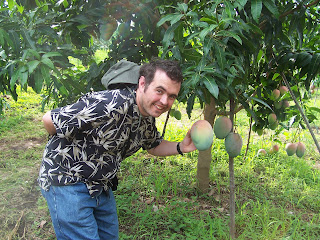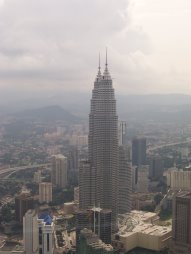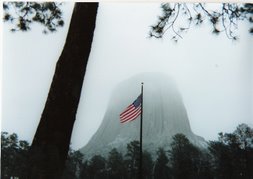What started out as a small action point in a rather large working document created and edited by pupils of Mr Dyer's Eco Group ended up with myself, Mr Dyer and Mr Bowen flying over the incredible red-brown of the Sahara desert to arrive in Accra, the capital city of Ghana.
We were met by one of Kwahu Province Ministers, Alex, who on the first night took us to a rather swanky hotel in Accra. So upmarket was this hotel that we decided against using our mosquito nets and indeed using DEET.
The next day we travelled on some concrete roads (built as part of the 50th anniversary of Ghanian independence) and some red road (though the word road is a misnomer). Red road is like the waltzers. Up and down you go with a few rockings from side to side.
Our destination was the mountain village of Abetifi. The climate was cool and rather appealing to the milky white Scots in our party. There we met Emmanuel, who was acting Moderator of the Church of Ghana, no mean feat!

During our stay in Abetifi we visited the large Mango Farm, the one that is the template for the smaller farm in Donkorkrom. We even got to see the £15,000 tractor, bought by donations raised by Mr Dyer's church and our school, Hamilton Grammar. The tractor cuts down the manual work and increases production!

The mangos were planted for two reasons. To help offset in a small way the carbon pollution created by organisations in Scotland, and secondly to offer a regular income to the local people.
From Abetifi off we went to catch the Ferry to Donkorkrom, over the world's biggest man made lake, Lake Volta! The scene we witnessed was one of the most memorable I have ever been a part of. Indeed Mr Bowen commented that it looked like something just out of a Michael Palin travelogue. Perhaps, but at least Michael Palin had a professional film crew with him!
The ferry was packed full of people, some in African garb and others wearing discarded Western clothes. People carrying goods on their head were commonplace, and quite a few merchants were selling some rather odd looking fish!
The ferry looked like the Western Ferry one takes to cross over from Gourock to Dunoon, a journey I have taken a few times, and one Mrs Munro (another member of our group) had taken a zillion times! Indeed she wondered whether our ferry was Clydebuilt.
After the ferry we had more red road to avoid being travel sick on, before we reached the beautiful rural area of Donkorkrom.
Our mission in Donkorkrom was a big one.
My role was to help in the school (Donkorkrom Agric Senior High School - DASHS for short), Mr Bowen and Mr Dyer were writing a partnership agreement between DASHS and Hamilton Grammar, while trainee doctor Kim Dyer (Mr Dyer's daughter) was leading the charge to the Spartanburg Orphanage, the beneficiaries of the majority of our fundraising.

The orphans usually had one parent alive, but they had been abandoned. There were House Mothers who looked after them, and an incredible man called Papa Anaba who ferried the kids to and from school and just about did everything for them. Oh and he could also seem to sort any vehicle problems with a little bit of TLC!
The orphans represented the side of Africa which is common on our TV screens. They were the emotional heart of our visit. The long term dream of Mr Dyer is to see the kids in the orphanage go to Nursery (which they do) then on to Primary, Middle School and then DASHS.
At DASHS we met Mr Robert Forsson, the Headmaster of the school. Some of us were also lucky enough to stay at the Headmaster's residence, where we were looked after very well, as we had in Abetifi.

We also met Victor 'Obama', the Head Boy. He was quite a character and indeed was DASHS's version of our own Stuart Bence!

We also were introduced to Chris and Tammi Martin, American Peace Corps Volunteers who were just a year into their own adventure. Chris is a Professor of Woodwork at Iowa State University, and Tammi is teaching ICT in DASHS. You can read their African Odyssey here:
http://www.chrismartinfurniture.blogspot.com/We also met the Chief of Donkorkrom and indeed the Afram Plains. It was an unusual ceremony because the Chief did not speak, but one of his sub-chiefs did. We were made very welcome and they were very happy with our mission.

At DASHS, we installed laptops donated by a college and thanks to Elorm aka Sunshine, we got the internet connection up and running. Pupils did a little PowerPoint (all kids love PowerPoint!) and also we did some Podcasting!
I also created a blog for Hamilton Grammar and DASHS to hopefully continue the partnership.
Papa Anaba took us to the Donkorkrom Mango Farm and we took some Thank You photographs for our kind sponsors.

There was also a football match between DASHS and the village. Mr Bowen and myself went on for a small part of the game, but the boys were fitter, stronger, faster. Mr Bowen played for about 30 minutes, but I am afraid to report I only went on for the last 5. I do have dodgy knees, but even so if Mr Bowen could pass the ball square in the 6 yard box I would have been celebrating my first goal outwith the British Isles!
The orphanage is not a sad place. Indeed the kids are well looked after and they have a ball. It is great to see a place were kids who are in need of love and attention receiving just that. It also hit home to me that perhaps many of our own pupils in Hamilton and in Scotland do not always received the emotional support that young people need. In that regards, I was very fortunate to have such a loving and compassionate Mum and Dad.
As a Teacher, I think being compassionate is a major part of the job. Yes we do have to be firm and fair, but we also must have empathy. Children are vulnerable and need on occassion someone to stick up for them, be kind to them, and make them laugh. That is the part of the job many people do not realise I feel. Teachers are people, we are not robots programmed to "EDUCATE!" like some Pedagological (is that a word?!) Dalek!
Kumasi is the second largest city in Ghana and we were treated to an incredible day and night there. Kumasi is more typically African (even though I know that there is no real Africa at all... Africa is so huge and so wildly different and diverse!) than the more Westernised Accra.
Kumasi was home to some beautiful wood carvings, where we had to haggle with the sculptors like something out of the Apprentice! I can safely say that I purchased two Lions, a giraffe, and an elephant for a few quid! Even though we would like to pay more, we risked creating jealousy and perhaps a bit of trouble for the vendors who were lucky to receive our Cedis (the Ghanian currency).
In Kumasi we visited the Palace of the Big, BIG Chief. Our guide reminded me of Frankie Howerd and his jokes and routine were quite superb. I have been to Verseille, the Louvre, Grand Canyon and a few other places in between with cracking Tour Guides, but our dear friend in Kumasi is the hands down champ.
The weather in Ghana was rather wet, which suited me because the heat could really have ruined a good sleep every night. Another plus is that Ghana is the same time zone as the UK!
The food consisted mainly of rice and free range chicken, though we did eat some meat. There were some little sausage things that I have to admit I really liked. The heat killed our appetites though, and I am not always one for a breakfast, lunch and dinner back home. In fact I rarely ever eat lunch, dating back to my uni days in the 1990s. Though since I have returned from Ghana I have been attending our school canteen for some health grub!
Ghanians do like their customs and meetings! It is required when visiting somewhere new to declare your intentions individually! And you give presents when you arrive and receive gifts when you leave! Poor old Santa must sweat when heading for West Africa!
Another interesting highlight was the historic visit of President Barack Obama to Ghana, his first visit to Sub-Saharan Africa. It was a controversial visit in that he rebuked the land of his ancestors (Kenya) to visit Ghana. Our Peace Corps friends Chris and Tammi were invited along with the other US Volunteers to wave Obama off at Accra airport. President John F. Kennedy formed the Peace Corps in 1961, and Ghana was the first destination of the Volunteers. Perhaps there was symbolism in Obama selecting Ghana?
Obama-mania was widespread. His speech was probably like Neil Armstrong landing on the moon. Every man, woman and child were glued to the TV set. Obama was rather straight forward in his speech and it was by no means a whitewash. He spoke freely of the corruption and civil fighting that had and was occurring in several African Nations. It was a brave, if well needed speech.
Obama also visited Cape Coast, which was a port and final call for many West Africans before they were shipped off as slaves to the New World. I would love to return to visit the museum and have time to reflect on the enormity of what happened to innocent people. In a way it must be similar in some aspects for Black people of West African descent to go to places like Cape Coast as it would be for Jewish Europeans to visit Auschwitz or Dachau.
An interesting fact was learned just after our visit. In Athletics, most of the world's top sprinters can trace their ancestory to West Africa due to their physical strength and bulky physiques. However, East Africa, with more slender frames and more mountainous regions are built for distance running! So no wonder Sir Chris Hoy took up cycling.
This incredible story is not yet over. In less than a week we will welcome Emmanuel and Robert Forsson to sunny Scotland and show them what life is like for us here.
And there is a development that Hamilton and Donkorkrom may end up as Twin Towns. If this did happen, then what an incredible legacy for Sinclair Dyer and Kim Dyer.
Kim is a medical student and she needed some extra experience. Sinclair wasn't sure what to do, but a Ghanian who had received some help from a relative for Mr Dyer told him to take Kim to Ghana. Against perhaps his better judgement he did. It seemed at first a strange and perhaps trouble-laden trip... but all the fears any father would have taking his little girl out to a strange new world was proven to be unfounded. The Ghanians treated Sinclair and Kim like their own.
And do you know what? They treated everyone of us like their own. They are a hard act to follow, that is for sure!

















